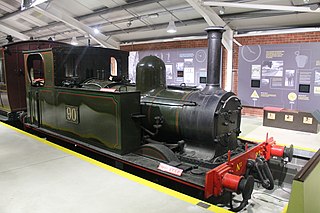
Rail transport in Ireland is provided by Iarnród Éireann in the Republic of Ireland and by Northern Ireland Railways in Northern Ireland.

Inchicore is a suburb of Dublin, Ireland. Located approximately 5 kilometres (3.1 mi) west of the city centre, Inchicore was originally a small village separate from Dublin. The village developed around Richmond Barracks and Inchicore railway works, before being incorporated into the expanding city bounds. Inchicore is a largely residential area and is home to the association football club St Patrick's Athletic FC.

Straffan is a village in County Kildare, Ireland, situated on the banks of the River Liffey, 25 km upstream of the Irish capital Dublin. As of the 2016 census, the village had a population of 853, a nearly two-fold increase since the 2006 census.
Although prototype diesel locomotives ran in Britain before World War II, the railways of both the Republic and Northern Ireland changed over much more rapidly from steam to diesel traction than those in Britain, due to the island's limited coal reserves and an ageing steam locomotive fleet.

The Iarnród Éireann (IÉ) / Northern Ireland Railways 201 Class locomotives are the newest and most powerful diesel locomotives operating in Ireland and were built between 1994 and 1995 by General Motors Diesel. They are model type JT42HCW, fitted with an EMD 12-710G3B engine of 3,200 hp (2,400 kW), weigh 108.862 tonnes and have a maximum speed of 164 km/h (102 mph).

The Córas Iompair Éireann 121 Class was a railway locomotive which was manufactured by General Motors Electro-Motive Division. These locomotives were in regular service on the Irish railway network until 2002, with the last two remaining in service until early 2008.

The CIE 141 Class locomotives were built in 1962 by General Motors Electro Motive Division (EMD) in the United States. Numbered B141 to B177, they were an updated version of the 121 Class locomotives, mechanically very similar but with cabs at each end.
A wide variety of hauled coaches have been used on the railways of Ireland. This page lists all those since 1945.

The Great Northern Railway V class steam locomotives were 4-4-0 three-cylinder compound locomotives built in 1932 by Beyer, Peacock & Company for the Great Northern Railway (Ireland).
The MGWR Classes F, Fa and Fb are a group of similar classes of 0-6-0 steam locomotives of the Midland Great Western Railway of Ireland which were designed and built between 1921 and 1924. The locomotives could be used to handle goods and also for passenger traffic.

The Railway Preservation Society of Ireland (RPSI) is a railway preservation group founded in 1964 and operating throughout Ireland. Mainline steam train railtours are operated from Dublin, while short train rides are operated up and down the platform at Whitehead, County Antrim, and as of 2023, the group sometimes operates mainline trains in Northern Ireland using hired-in NIR diesel trains from Belfast. The RPSI has bases in Dublin and Whitehead, with the latter having a museum. The society owns heritage wagons, carriages, steam engines, diesel locomotives and metal-bodied carriages suitable for mainline use.

The Great Southern and Western Railway Class 90 is a class of 0-6-0T steam locomotive. They were one of the smallest steam locomotives to be inherited by the CIÉ on its formation.

The GS&WR Class 101, classified as Class 101 or Class J15 by the Great Southern Railways, was a class of 0-6-0 steam locomotives designed for working goods traffic although they did, and were quite capable of, working branch and secondary passenger trains.

The Augsburg Railway Park is a railway museum in Augsburg on part of the former Augsburg locomotive shed owned by the Deutsche Bahn. Following reconstruction work, the park officially reopened on 13 April 2009. In the future, 29 historic locomotives from the EU member countries and also Switzerland will be exhibited in the roundhouse and on the turntable, the so-called Europa Roundhouse, which are protected historical buildings. In addition to the roundhouse there are also three historical steam locomotive halls with a workshop atmosphere and a historical smithy.
Straffan was a station located 2+1⁄2 miles (3.5 km) from Straffan in County Kildare, Ireland. It also served the village of Ardclough.

Inchicore railway works, also known locally as 'Inchicore' or 'The Works', was founded by the Great Southern and Western Railway in 1846 and emerged to become the major engineering centre for railways in Ireland. Located c. 3 km west of Dublin city centre, the works cover an area of approximately 73 acres (300,000 m2).

The Midland Great Western Railway (MGWR) A Class, later Inchicore Class D5, consisted of 6 4-4-0 express passenger locomotives built at Broadstone Works in the period 1902-1905. The largest express passenger locomotive in Ireland for a short while after introduction they were used on the MGWR's flagship services to Galway with most surviving until the 1950s albeit on less prestigious work.
St. Jude's Church, on the Inchicore Road, Kilmainham, in Dublin, Ireland, was a Church of Ireland (Anglican) church built between 1862 and 1864 to serve the community working in the nearby railway works, and serving the St. Jude's Parish, which included Goldenbridge, Kilmainham, and Inchicore.
















